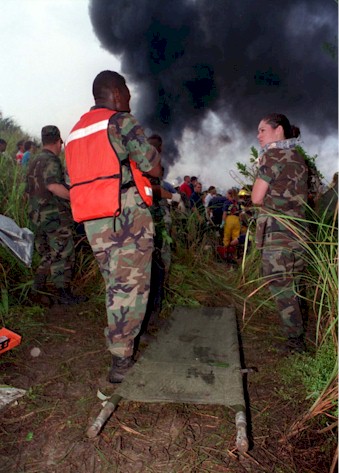 Aircraft Mishap Information* Aircraft Mishap Information*
PRE-MISHAP
RESPONSIBLITIES
An
aircraft mishap is a catastrophic event which is never planned for but one which
requires prompt, precise actions on the part of all respondents. The role of the medical department in the mishap scenario is
key and if not conducted properly, can lead to unnecessary morbidity and
mortality as well as cause a deterioration of evidence which might potentially
lead to the discovery of the cause of the mishap.
If you are the Senior Medical Department Representative (SMDR) of a
command that could be involved in the response to an aircraft mishap, it is of
paramount importance you have contingencies clear in your mind, as well in the
minds of all those who will participate in the response with you, of the role
your medical department will play in the mishap response.
The
primary responsibility of all medical personnel at the time of a mishap is to
preserve life and limb. The details
of mass casualty response are beyond the scope of this chapter and the SMDR is
referred to the appropriate references.
In
preparation for a mishap response, an essential reference for your department
files is OPNAVINST 3750.6 (or the most recent update) that spells out the
details of pre-mishap planning, mishap response and mishap investigation.
Sound
pre-mishap planning and training are required to ensure a successful response.
Ensure you have the means of notifying local rescue, fire fighting,
coroner and logistics support, whether military or civilian.
Meeting with the supervisors of responding agencies, as well as local
hospitals, is essential. When
feasible, cooperative training evolutions should be conducted.
All
personnel in the medical department must be fully prepared for the role they
will play in the event of an aircraft mishap. It is key that all personnel
understand that the command Public Affairs Officer (PAO) is the only command
representative that may release information to the press.
Medical
personnel assigned to duties in the field with the investigating flight surgeon
must be appraised of techniques of evidence gathering and of means of properly
recording observations. Ensure that
all ordinance and ejection mechanisms are secured prior to personnel deploying
into the mishap scene proper. When
searching wreckage, personnel must wear adequate personal protective equipment.
Be particularly mindful of the risk of blood borne pathogens that might
contaminate the scene. Adequate photographic capabilities are required to document the relationship of remains, wreckage
and surrounding landmarks. Always
include a clear plastic ruler with easily identifiable markings for close up
photographs.
Laboratory
personnel must be aware of the blood samples that must be drawn on all survivors
(see below). The proper colored
tubes in the proper numbers per survivor must be banded together with the blank
forms necessary for processing. Radiology
personnel need to be prepared to conduct the full complement of required films
based on the injuries sustained. Full
spinal radiographs are required on all personnel after ejections, bailouts and
crashes, regardless of whether back injury is suspected.
Those sustaining fatal injuries must be radiographed wearing flight gear
as well as without.
In
the event of a fatality, the SMDR can expect to work in close association with
personnel from the Naval Safety Center and the Armed Forces Institute of
Pathology (AFIP). Your command must
have the most current emergency telephone numbers for these agencies.
A
mishap investigation kit must be assembled and properly maintained.
The purpose of this kit is to have the equipment available to safely and
properly respond to and to record those elements leading up to and subsequent to
the mishap. Items can be personalized but should include certain
essentials. Such a kit might
include;
Reference/Forms
POST
MISHAP RESPONSIBILITIES
Care
of survivors is the ultimate responsibility of medical personnel. Perform full
physical exams on all survivors and immediately secure their medical and dental
records as well as their flight gear. Betadine
and water are to be used for skin preparation prior to drawing labs.
DO NOT USE ALCOHOL RUBS ON THE SKIN.
Locally run laboratories include serum
glucose, CBC, UA and
SMA-12.
AFIP requires samples to measure serum ETOH
levels, CO levels and drug
screen.
While
in the field, the remains of the deceased should not be disturbed prior to
completion of photographic documentation. Body
fluids should not be obtained from the deceased in the field.
Fluid collection on the deceased will be conducted during the autopsy. Body parts and personal effects should be tagged and
photographed where they are found. Do
not remove personal equipment from the body prior to radiographs being taken.
All
information related to an aircraft mishap is privileged.
Medical personnel must ensure that all information obtained in the course
of the performance of the medical mission is relayed to the Aircraft Mishap
Board. Such information would
include that obtained in a standard post mishap aeromedical questionnaire which,
besides the elements of a good demographic and medical history, also includes
questions pertinent to the mishap flight from brief to termination.
To assist in the human factors analysis of the mishap, make every effort
to establish a clear 72 hr. pre-mishap medical history
If fatalities result, other squadron personnel must be questioned
immediately to establish an accurate 72 hr. pre-mishap history of the deceased.
This section was contributed by CAPT
Mike McCarten, MC, USN (FS).
*Source:
Operational Medicine 2001, Health
Care in Military Settings, NAVMED P-5139, May 1, 2001, Bureau
of Medicine and Surgery, Department of the Navy, 2300 E Street NW, Washington,
D.C., 20372-5300 |


 Aircraft Mishap Information*
Aircraft Mishap Information*